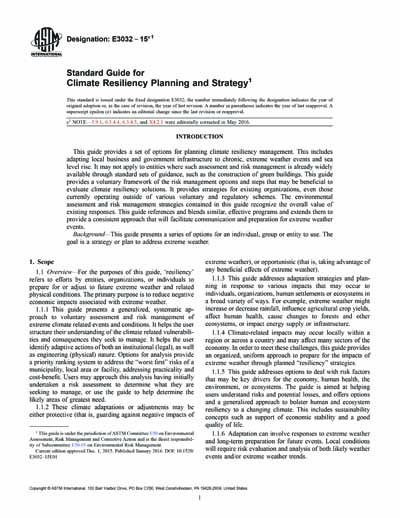Historical
ASTM E3032-15e1
Standard Guide for Climate Resiliency Planning and Strategy
1.1 Overview—For the purposes of this guide, ‘resiliency’ refers to efforts by entities, organizations, or individuals to prepare for or adjust to future extreme weather and related physical conditions. The primary purpose is to reduce negative economic impacts associated with extreme weather.
1.1.1 This guide presents a generalized, systematic approach to voluntary assessment and risk management of extreme climate related events and conditions. It helps the user structure their understanding of the climate related vulnerabilities and consequences they seek to manage. It helps the user identify adaptive actions of both an institutional (legal), as well as engineering (physical) nature. Options for analysis provide a priority ranking system to address the “worst first” risks of a municipality, local area or facility, addressing practicality and cost-benefit. Users may approach this analysis having initially undertaken a risk assessment to determine what they are seeking to manage, or use the guide to help determine the likely areas of greatest need.
1.1.2 These climate adaptations or adjustments may be either protective (that is, guarding against negative impacts of extreme weather), or opportunistic (that is, taking advantage of any beneficial effects of extreme weather).
1.1.3 This guide addresses adaptation strategies and planning in response to various impacts that may occur to individuals, organizations, human settlements or ecosystems in a broad variety of ways. For example, extreme weather might increase or decrease rainfall, influence agricultural crop yields, affect human health, cause changes to forests and other ecosystems, or impact energy supply or infrastructure.
Content Provider
ASTM International [astm]






